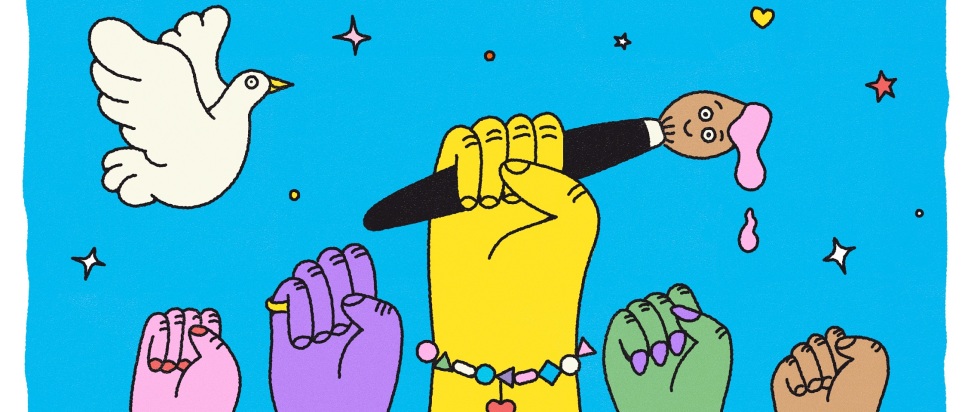Learning red with Glasgow's Red Sunday School
Glasgow’s Red Sunday School is encouraging children to think differently. We chat to them about children’s agency, community building, and connecting to Scotland’s radical past
“It’s supposed to be fun,” says Katherine Mackinnon, one of several committee members for Red Sunday School. And it certainly seems fun: children are singing about the rent strikes; they’re making May Day banners; they’re playing games in the rare Scottish spring sun. The children at the school, based in Glasgow’s southside, are most definitely having fun.
The school was pulled together by a group of historians, artists, writers, and teachers, among others. It’s been in the works for a couple of years but – like most things in the COVID era – was pushed back until recent months. “It’s not a party-affiliated thing and it’s not a religious thing,” explains Mackinnon. Rather, Red Sunday School is simply a space where children are encouraged to think freely about the world around them. Here, away from the rigidity of formal education, children can truly question things – and make some noise while doing so. It’s ultimately based on socialist principles but also draws on anti-racism, feminism, and climate justice.
The school is based at the recently re-opened Kinning Park Complex. It was once occupied by members of the community (for 55 days, no less) and is now a vibrant, community-owned space. As such, it’s fitting that a certain radicalism continues to fill it.
But it taps into Glasgow’s radical past in more ways than one. From 1890 to 1980, the Socialist Sunday School movement flourished in Glasgow. For children attending, the schools allowed children to learn about and engage with the workers' movement. Now, Red Sunday School seeks to reconnect with this radical tradition, bringing it into focus under a 21st century lens. The committee has done plenty of digging around the archives: “Things have changed, but there's lots of really cool stuff – there was colouring in sheets!”
During each Red Sunday School session, the children go into age-based groups to complete activities surrounding socialist principles and radical history. After, everyone shares a sit-down meal. It’s about togetherness: Red Sunday School isn’t simply teaching children Marx; it’s also creating a real sense of community.
And such community is much-needed. Outwith religious communities, it can seem like annual celebrations are few and far between. For Mackinnon, however, Red Sunday School provides a community through which an “alternative calendar” may be formed. Within radical history itself, there are certainly dates that ought to be collectively remembered, dates that ought to be collectively celebrated – like May Day, of course. “I really like the idea of [May Day] being something we celebrate where we look at the history of it, what’s happening now, and what can be done,” Mackinnon says. There’s a real potential for a different kind of joyful togetherness – in an age where many of us are increasingly distant from our local communities, it feels very necessary and very exciting.
Crucially, this celebration-worthy radical past is children’s past, too. “So many of these things involve children, like the rent strikes – kids were there throwing bags of flour at the bailiffs,” Mackinnon says. “This was tailor-made for engaging children.” This is children’s history; this is their history – and they have a right to know about it. “I feel like there’s something really joyful about kids being able to draw on that and feel like [they’re] part of a chain.”
Children’s place in all this is key. In the future, the school plan to introduce a children’s committee, through which children attending will have a say in the school’s running. In this, Red Sunday School rejects that stuffy, old-fashioned ‘do what I say and not what I do’: here, a collective which encourages children to think for themselves allows such thought to manifest into action, directly impacting their curriculum. “Why shouldn’t kids have more autonomy over these things?” Mackinnon asks. It’s their education, afterall.
“When it’s aimed at children, it makes you understand it better because it has to drill down to the very essence of the thing,” explains Mackinnon. So many of us are guilty of throwing around the odd, radical-sounding term without truly understanding it. “Sometimes people can be a bit full-on with the theory [...] There can be a bit of gatekeeping.” Shifting the focus on to children breaks down some of these walls – for the kids, of course, but also for adults. Educating the next generation also means better educating ourselves.
Red Sunday School is full of joyful promise: the revival of this past movement seeks to make both the present and the future that bit better for all of us, children and adults. The school doesn’t terrify children with tales of Tory Britain horrors; rather, it educates, inspires, and unites. “You need to find something positive,” says Mackinnon. “You need to find something that you are able to have some agency over.” Red Sunday School seems to be exactly that.
